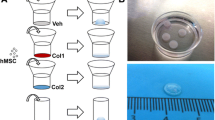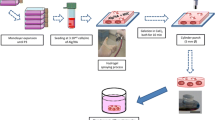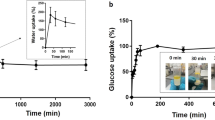Abstract
Introduction
Spheroids of mesenchymal stem cells (MSCs) in cartilage tissue engineering have been shown to enhance regenerative potential owing to their 3D structure. In this study, we explored the possibility of priming spheroids under different media to replace the use of inductive surface coatings for chondrogenic differentiation.
Methods
Rat bone marrow-derived MSCs were organized into cell spheroids by the hanging drop technique and subsequently cultured on hyaluronic acid (HA) coated or non-coated well plates under different cell media conditions. Endpoint analysis included cell viability, DNA and Glycosaminoglycan (GAG) and collagen content, gene expression and immunohistochemistry.
Results
For chondrogenic applications, MSC spheroids derived on non-coated surfaces outperformed the spheroids derived from HA-coated surfaces in matrix synthesis and collagen II gene expression. Spheroids on non-coated surfaces gave rise to the highest collagen and GAG when primed with medium containing insulin-like growth factor (IGF) for 1 week during spheroid formation. Spheroids that were grown in chondroinductive raw material-inclusive media such as aggrecan or chondroitin sulfate exhibited the highest Collagen II gene expression in the non-coated surface at 1 week.
Conclusion
Media priming by growth factors and raw materials might be a more predictive influencer of chondrogenesis compared to inductive-surfaces. Such tailored bioactivity of the stem cell spheroids in the stage of the spheroid formation may give rise to a platform technology that may eventually produce spheroids capable of chondrogenesis achieved by mere media manipulation, skipping the need for additional culture on a modified surface, that paves the way for cost-effective technologies.








Similar content being viewed by others
References
Arufe, M., A. De la Fuente, I. Fuentes-Boquete, F. J. De Toro, and F. J. Blanco. Differentiation of synovial CD-105 + human mesenchymal stem cells into chondrocyte-like cells through spheroid formation. J. Cell. Biochem. 108:145–155, 2009.
Baraniak, P. R., M. T. Cooke, R. Saeed, M. A. Kinney, K. M. Fridley, and T. C. McDevitt. Stiffening of human mesenchymal stem cell spheroid microenvironments induced by incorporation of gelatin microparticles. J. Mech. Behav. Biomed. Mater. 11:63–71, 2012.
Baraniak, P. R., and T. C. McDevitt. Scaffold-free culture of mesenchymal stem cell spheroids in suspension preserves multilineage potential. Cell Tissue Res. 347:701–711, 2012.
Barry, F. P., and J. M. Murphy. Mesenchymal stem cells: clinical applications and biological characterization. Int. J. Biochem. Cell Biol. 36:568–584, 2004.
Bartosh, T. J., and J. H. Ylostalo. Preparation of anti‐inflammatory mesenchymal stem/precursor cells (MSCs) through sphere formation using hanging‐drop culture technique. Curr. Protocols Stem Cell Biol. 28:2B. 6.1–2B. 6.23, 2014.
Bartosh, T. J., J. H. Ylöstalo, A. Mohammadipoor, N. Bazhanov, K. Coble, K. Claypool, R. H. Lee, H. Choi, and D. J. Prockop. Aggregation of human mesenchymal stromal cells (MSCs) into 3D spheroids enhances their antiinflammatory properties. Proc. Natl. Acad. Sci. 107:13724–13729, 2010.
Bulpitt, P., and D. Aeschlimann. New strategy for chemical modification of hyaluronic acid: preparation of functionalized derivatives and their use in the formation of novel biocompatible hydrogels. J. Biomed. Mater. Res. 47:152–169, 1999.
Burdick, J. A., and G. D. Prestwich. Hyaluronic acid hydrogels for biomedical applications. Adv. Mater. 23:H41–H56, 2011.
Cals, F. L. J., C. A. Hellingman, W. Koevoet, R. J. B. de Jong, and G. J. V. M. van Osch. Effects of transforming growth factor-ss subtypes on in vitro cartilage production and mineralization of human bone marrow stromal-derived mesenchymal stem cells. J. Tissue Eng. Regen. Med. 6:68–76, 2012.
Cucchiarini, M., and H. Madry. Overexpression of human IGF-I via direct rAAV-mediated gene transfer improves the early repair of articular cartilage defects in vivo. Gene Ther. 21:811–819, 2014.
Fan, H., Y. Hu, L. Qin, X. Li, H. Wu, and R. Lv. Porous gelatin–chondroitin–hyaluronate tri-copolymer scaffold containing microspheres loaded with TGF-β1 induces differentiation of mesenchymal stem cells in vivo for enhancing cartilage repair. J. Biomed. Mater. Res. Part A. 77:785–794, 2006.
Fennema, E., N. Rivron, J. Rouwkema, C. van Blitterswijk, and J. de Boer. Spheroid culture as a tool for creating 3D complex tissues. Trends Biotechnol. 31:108–115, 2013.
Grimaud, E., D. Heymann, and F. Rédini. Recent advances in TGF-β effects on chondrocyte metabolism: potential therapeutic roles of TGF-β in cartilage disorders. Cytokine Growth Factor Rev. 13:241–257, 2002.
Gupta, V., N. Mohan, and M. S. Detamore. Microsphere-based scaffolds carrying opposing gradients of chondroitin sulfate and tricalcium phosphate. Frontiers Bioeng. Biotechnol. 2015. 10.3389/fbioe.2015.00096.
Hatsushika, D., T. Muneta, T. Nakamura, M. Horie, H. Koga, Y. Nakagawa, K. Tsuji, S. Hishikawa, E. Kobayashi, and I. Sekiya. Repetitive allogeneic intraarticular injections of synovial mesenchymal stem cells promote meniscus regeneration in a porcine massive meniscus defect model. Osteoarthr Cartil. 22:941–950, 2014.
Ingavle, G. C., A. W. Frei, S. H. Gehrke, and M. S. Detamore. Incorporation of aggrecan in interpenetrating network hydrogels to improve cellular performance for cartilage tissue engineering. Tissue Eng. Part A. 19:1349–1359, 2013.
Jaklenec, A., A. Hinckfuss, B. Bilgen, D. M. Ciombor, R. Aaron, and E. Mathiowitz. Sequential release of bioactive IGF-I and TGF-β 1 from PLGA microsphere-based scaffolds. Biomaterials. 29:1518–1525, 2008.
Jo, C. H., Y. G. Lee, W. H. Shin, H. Kim, J. W. Chai, E. C. Jeong, J. E. Kim, H. Shim, J. S. Shin, and I. S. Shin. Intra-articular injection of mesenchymal stem cells for the treatment of osteoarthritis of the knee: a proof-of-concept clinical trial. Stem Cells. 32:1254–1266, 2014.
Kim, I. L., R. L. Mauck, and J. A. Burdick. Hydrogel design for cartilage tissue engineering: A case study with hyaluronic acid. Biomaterials. 32:8771–8782, 2011.
Kock, L. M., R. M. Schulz, C. C. van Donkelaar, C. B. Thümmler, A. Bader, and K. Ito. RGD-dependent integrins are mechanotransducers in dynamically compressed tissue-engineered cartilage constructs. J. Biomech. 42:2177–2182, 2009.
Kramer, J., F. Böhrnsen, U. Lindner, P. Behrens, P. Schlenke, and J. Rohwedel. In vivo matrix-guided human mesenchymal stem cells. Cell. Mol. Life Sci. 63:616–626, 2006.
Krampera, M., G. Pizzolo, G. Aprili, and M. Franchini. Mesenchymal stem cells for bone, cartilage, tendon and skeletal muscle repair. Bone. 39:678–683, 2006.
Lai, J.-Y., and I-H Tu Adhesion. phenotypic expression, and biosynthetic capacity of corneal keratocytes on surfaces coated with hyaluronic acid of different molecular weights. Acta Biomater. 8:1068–1079, 2012.
Lee, J., M. Sato, H. Kim, and J. Mochida. Transplantation of scaffold-free spheroids composed of synovium-derived cells and chondrocytes for the treatment of cartilage defects of the knee. Eur Cell Mater. 22:275–290, 2011.
Lewis, N. S., E. E. Lewis, M. Mullin, H. Wheadon, M. J. Dalby, and C. C. Berry. Magnetically levitated mesenchymal stem cell spheroids cultured with a collagen gel maintain phenotype and quiescence. J. Tissue Eng. 8:2041731417704428, 2017.
Loessner, D., K. S. Stok, M. P. Lutolf, D. W. Hutmacher, J. A. Clements, and S. C. Rizzi. Bioengineered 3D platform to explore cell–ECM interactions and drug resistance of epithelial ovarian cancer cells. Biomaterials. 31:8494–8506, 2010.
Madry, H., G. Kaul, D. Zurakowski, G. Vunjak-Novakovic, and M. Cucchiarini. Cartilage constructs engineered from chondrocytes overexpressing IGF-I improve the repair of osteochondral defects in a rabbit model. Eur Cell Mater. 25:229–247, 2013.
Martinez, I., J. Elvenes, R. Olsen, K. Bertheussen, and O. Johansen. Redifferentiation of in vitro expanded adult articular chondrocytes by combining the hanging-drop cultivation method with hypoxic environment. Cell Transplant. 17:987–996, 2008.
Mellott, A. J., M. E. Godsey, H. E. Shinogle, D. S. Moore, M. L. Forrest, and M. S. Detamore. Improving viability and transfection efficiency with human umbilical cord Wharton’s jelly cells through use of a ROCK inhibitor. Cell. Reprogramm. 16:91–97, 2014.
Miller, M. J., S. Ahmed, P. Bobrowski, and T. M. Haqqi. The chrondoprotective actions of a natural product are associated with the activation of IGF-1 production by human chondrocytes despite the presence of IL-1β. BMC Complement Altern. Med. 6:13, 2006.
Mohan, N., V. Gupta, B. Sridharan, A. Sutherland, and M. S. Detamore. The potential of encapsulating “raw materials” in 3D osteochondral gradient scaffolds. Biotechnol. Bioeng. 111:829–841, 2014.
Murphy, K. C., S. Y. Fang, and J. K. Leach. Human mesenchymal stem cell spheroids in fibrin hydrogels exhibit improved cell survival and potential for bone healing. Cell Tissue Res. 357:91–99, 2014.
Ng, K., J. DeFrancis, L. Kugler, T.-A. Kelly, M. Ho, C. O’Conor, G. Ateshian, and C. Hung. Amino acids supply in culture media is not a limiting factor in the matrix synthesis of engineered cartilage tissue. Amino Acids. 35:433–438, 2008.
Orozco, L., A. Munar, R. Soler, M. Alberca, F. Soler, M. Huguet, J. Sentís, A. Sánchez, and J. García-Sancho. Treatment of knee osteoarthritis with autologous mesenchymal stem cells: A pilot study. Transplantation. 95:1535–1541, 2013.
Siddappa, R., R. Licht, C. van Blitterswijk, and J. de Boer. Donor variation and loss of multipotency during in vitro expansion of human mesenchymal stem cells for bone tissue engineering. J. Orthop. Res. 25:1029–1041, 2007.
Spiller, K. L., Y. Liu, J. L. Holloway, S. A. Maher, Y. Cao, W. Liu, G. Zhou, and A. M. Lowman. A novel method for the direct fabrication of growth factor-loaded microspheres within porous nondegradable hydrogels: Controlled release for cartilage tissue engineering. J. Controlled Rel. 157:39–45, 2012.
Sridharan, B., A. D. Laflin, M. A. Holtz, D. M. Pacicca, N. K. Wischmeier, and M. S. Detamore. In vivo evaluation of stem cell aggregates on osteochondral regeneration. J. Orthop. Res. 35(8):1606–1616, 2016.
Tan, H., C. R. Chu, K. A. Payne, and K. G. Marra. Injectable in situ forming biodegradable chitosan–hyaluronic acid based hydrogels for cartilage tissue engineering. Biomaterials. 30:2499–2506, 2009.
Vinardell, T., E. J. Sheehy, C. T. Buckley, and D. J. Kelly. A comparison of the functionality and in vivo phenotypic stability of cartilaginous tissues engineered from different stem cell sources. Tissue Eng. Part A. 18:1161–1170, 2012.
Wang, L., and M. S. Detamore. Effects of growth factors and glucosamine on porcine mandibular condylar cartilage cells and hyaline cartilage cells for tissue engineering applications. Archives of oral biology 54:1–5, 2009.
Wang, L., and M. S. Detamore. Insulin-like growth factor-I improves chondrogenesis of predifferentiated human umbilical cord mesenchymal stromal cells. J. Orthop. Res. 27:1109–1115, 2009.
Wilson, R., D. Belluoccio, C. B. Little, A. J. Fosang, and J. F. Bateman. Proteomic characterization of mouse cartilage degradation in vitro. Arthritis Rheum. 58:3120–3131, 2008.
Winter, A., S. Breit, D. Parsch, K. Benz, E. Steck, H. Hauner, R. M. Weber, V. Ewerbeck, and W. Richter. Cartilage-like gene expression in differentiated human stem cell spheroids: A comparison of bone marrow–derived and adipose tissue–derived stromal cells. Arthritis Rheum. 48:418–429, 2003.
Xu, F., B. Sridharan, S. Wang, U. A. Gurkan, B. Syverud, and U. Demirci. Embryonic stem cell bioprinting for uniform and controlled size embryoid body formation. Biomicrofluidics. 5:022207, 2011.
YlÖstalo, J. H., T. J. Bartosh, K. Coble, and D. J. Prockop. Human mesenchymal stem/stromal cells cultured as spheroids are self-activated to produce prostaglandin E2 that directs stimulated macrophages into an anti-inflammatory phenotype. Stem Cells. 30:2283–2296, 2012.
Yoon, H. H., S. H. Bhang, J.-Y. Shin, J. Shin, and B.-S. Kim. Enhanced cartilage formation via three-dimensional cell engineering of human adipose-derived stem cells. Tissue Eng. Part A. 18:1949–1956, 2012.
Compliance with Ethical Standards
The National Institute of Arthritis and Musculoskeletal and Skin Diseases of the National Institutes of Health under Award Number R01 AR056347 supported research reported in this publication. The content is solely the responsibility of the authors and does not necessarily represent the official views of the National Institutes of Health. We would also like to recognize support from the Kansas Bioscience Authority Rising Star Award. BanuPriya Sridharan, Amy D. Laflin, and Michael S. Detamore, have no financial or intellectual property conflicts to disclose. All applicable international, national, and/or institutional guidelines for the care and use of animals were followed. This article does not contain any studies with human participants performed by any of the authors.
Author information
Authors and Affiliations
Corresponding author
Additional information
Associate Editor Michael R. King oversaw the review of this article.
Rights and permissions
About this article
Cite this article
Sridharan, B., Laflin, A.D. & Detamore, M.S. Generating Chondromimetic Mesenchymal Stem Cell Spheroids by Regulating Media Composition and Surface Coating. Cel. Mol. Bioeng. 11, 99–115 (2018). https://doi.org/10.1007/s12195-017-0517-4
Received:
Accepted:
Published:
Issue Date:
DOI: https://doi.org/10.1007/s12195-017-0517-4




